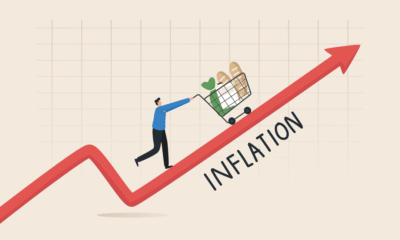Business
Rising Bond Yields: Why Stock-Market Investors are Feeling the Yips

Introduction to Bond Yields
Bond yields represent the return an investor can expect to earn on a bond, an important instrument in the realm of fixed-income investments. Essentially, a bond is a loan made by an investor to a borrower, typically corporate or governmental. When an investor purchases a bond, the borrower agrees to pay interest at defined intervals and repay the principal amount upon maturity. The bond yield, therefore, reflects the annual return relative to the bond’s price. This yield is influenced by various factors, including interest rates set by central banks, the creditworthiness of the issuer, and overall economic conditions.
Interest rates and bond yields demonstrate an inverse relationship: when interest rates rise, existing bond prices fall, causing yields to increase. Conversely, when interest rates decline, the prices of existing bonds rise, leading to diminished yields. This dynamic is crucial for investors as it shapes their strategies and expectations. As such, changes in bond yields can have significant implications for the broader financial market, including the stock market.
The fluctuations in bond yields can trigger shifts in investor sentiment and allocation strategies across various asset classes. Rising yields may prompt stock-market investors to reassess their portfolios, understanding that higher yields often indicate increased borrowing costs for companies, potentially hindering profit margins. Furthermore, attractive bond yields can lure investors away from equities into fixed-income securities, leading to possible sell-offs in the stock market. Therefore, a comprehensive understanding of bond yields and their relationship with market dynamics is essential for investors seeking to navigate the complexities of the financial landscape.
The Current State of Bond Yields
As of October 2023, bond yields have experienced a notable surge, reflecting a range of economic factors and investor sentiments that warrant careful examination. Historically, bond yields have fluctuated based on various macroeconomic indicators, including inflation rates, central bank policy decisions, and overall market dynamics. This evolution has significant implications not only for fixed-income investors but also for stock-market participants.
The rise in bond yields can be chiefly attributed to heightened inflation expectations. Investors are increasingly wary of persistent inflation, which often leads to higher interest rates as central banks attempt to rein in price growth. The U.S. Federal Reserve, for instance, has signaled its readiness to tighten monetary policy, thereby influencing yield curves across various maturities. Such movements indicate a shift in market expectations where rising yields signal a higher cost of borrowing, which can have direct implications for corporate profitability and, consequently, equity valuations.
In addition to inflation, central bank policies play a critical role in shaping bond market dynamics. The transition from a prolonged period of low interest rates to a more aggressive tightening environment indicates a pivotal change. Investors have grown accustomed to a low-yield environment, but the recent shifts in policy are prompting a reassessment of risk and return across asset classes. The market sentiment, characterized by caution, has led to increased volatility as equity investors process the implications of rising bond yields on future earnings and capital flows.
Amidst these developments, it is essential for stakeholders to monitor bond yields closely, as they are instrumental in shaping the broader investment landscape. The current state of bond yields is a reflection of complex interactions among inflation outlooks, central bank strategies, and changing investor sentiments. Understanding these trends is crucial for investors seeking to navigate the complexities of both fixed-income and equity markets effectively.
Correlation Between Bond Yields and Stock Markets
The relationship between bond yields and stock market performance is intricate and warrants a thorough examination to understand the current market dynamics. Generally, bond yields are viewed as an indicator of interest rates, directly impacting borrowing costs for corporations. As bond yields rise, the associated increase in interest rates can elevate the costs of capital for companies. This rise in borrowing expenses tends to lead to reduced corporate profits, subsequently translating into lower stock valuations. Investors often view bonds as safer assets, leading to a shift in investor preference from equities to fixed-income securities, pressuring stock prices downward.
Moreover, a rise in bond yields can signal an improving economy, which, at first glance, may seem beneficial for stocks. However, the flip side is that as investors anticipate higher inflation, they may adjust their outlook on corporate earnings, leading to increased skepticism toward high valuations in the stock market. Valuations, particularly those of growth stocks that rely heavily on future earnings, can face significant pressures in an environment where bond yields are climbing. As the yield on bonds rises, the present value of those future cash flows diminishes, making stocks less attractive in comparison.
In addition, the correlation between rising bond yields and stock market downturns can reflect broader economic sentiments. When bond markets start signaling concern about inflation or government fiscal policy, equity investors often react by reassessing risk levels in their portfolios. This phenomenon can trigger a sell-off in stock markets, compounding the effects of rising yields. The relationship is thus cyclical; as stock prices decline, corporate growth projections can further accelerate the shift of capital back into bonds, establishing a feedback loop that continues to affect both markets. As such, understanding the nuances of this correlation is essential for investors trying to navigate the complexities of today’s financial landscape.
Investor Sentiment and Behavioral Finance
The relationship between rising bond yields and investor sentiment is deeply intertwined with the principles of behavioral finance. As bond yields increase, stock-market investors may find their confidence shaken, eliciting a natural response of anxiety often referred to as “the yips.” This phenomenon can be understood better when viewing it through the lens of psychological factors that govern decision-making in financial markets.
One predominant factor contributing to this investor anxiety is risk aversion. Many investors, when faced with a rising yield environment, may perceive this as an impending increase in market volatility. As bond yields climb, the opportunity cost of holding stocks becomes more significant, which can lead to a shift in asset allocation. This tendency toward conservatism is a natural inclination; when faced with uncertainty about market conditions, investors often prioritize capital preservation over potential gains. Consequently, this leads to market fluctuations as individuals become increasingly cautious, resulting in a ripple effect characterized by overall market panic.
Moreover, herd behavior plays a crucial role in shaping investor reactions during periods of rising bond yields. When individuals observe others selling stocks or withdrawing from the market, it initiates a collective response that tends to amplify the initial sentiment. This collective behavior can skew market dynamics, creating an environment ripe for overreactions that further exacerbate the perceived risk associated with equities. As investors watch their peers react, they may feel an inherent pressure to follow suit, not wanting to miss out on the safety that bonds might seemingly offer in comparison to an unstable stock market.
Understanding these psychological components helps demystify the ‘yips’ that many investors experience during periods of rising bond yields. The interplay of risk aversion, market panic, and herd behavior encapsulates the complex nature of investor sentiment, illustrating that financial decisions are rarely based solely on rational assessments. Instead, they are often shaped by emotional responses to prevailing market conditions.
Sector-Specific Reactions to Rising Yields
The impact of rising bond yields on the stock market can vary significantly across different sectors, with some benefiting while others may face headwinds. Understanding these sector-specific reactions is crucial for investors navigating the current economic landscape.
First, the technology sector tends to respond negatively to increasing bond yields. Rising yields usually signal higher borrowing costs which, in turn, can affect the profitability of tech companies that rely on debt for growth. For instance, companies in the technology space often prioritize investment in innovation, and as lending rates rise, these investments may be curtailed. Historical trends show that when the yield on 10-year Treasury bonds has spiked, major tech stocks have frequently experienced a decline, as seen in recent trading periods.
Conversely, the financial services sector can benefit from rising bond yields. Banks and financial institutions generally see an improvement in profit margins as the yield curve steepens, which allows them to borrow at lower rates and lend at higher rates. For example, major banks reported increased net interest income as yields rose, leading to improved earnings outlooks. Furthermore, financial stocks often rally in anticipation of Federal Reserve rate hikes, which further supports their growth potential in a rising yield environment.
In contrast, utilities tend to struggle amid increasing yields. This sector is characterized by high dividend payouts and stable earnings, making them less attractive when returns on safer investments like bonds increase. Utility stocks are often viewed as bond proxies, and as bond yields rise, investors may shift their focus away from high-dividend-paying sectors. For instance, data indicates that utility stock performance tends to lag during periods of rising yields, as seen in the fluctuations observed over the last several quarters.
In summary, different sectors react uniquely to rising bond yields, influenced by their underlying financial structures and market expectations. Investors should carefully analyze these dynamics as they adjust their portfolios in response to changing economic conditions.
Historical Case Studies of Yield Rises
The relationship between bond yields and stock market performance has been a subject of analysis for economists and investors alike. Historical case studies offer valuable insights, illustrating how shifts in bond yields can influence equity markets. One pertinent example is the yield increase during the 1970s, a period marked by rising inflation and economic uncertainty. As the Federal Reserve raised interest rates to combat inflation, bond yields surged, which in turn pressured stock prices. The S&P 500 index experienced significant volatility during this period, often responding negatively to the upward trend in yields as investors recalibrated their portfolios.
Another noteworthy case occurred in the early 2000s, particularly around 2004, when the Federal Reserve initiated a series of rate hikes signaling an economic recovery from the recession. Bond yields climbed steadily, leading to a reassessment among equity investors. In this context, stock market participants faced increased competition for capital from fixed-income securities, which offered more attractive returns. Subsequently, the major indices exhibited a mixed performance, with sectors sensitive to interest rates, such as technology, experiencing notable declines.
Fast forward to the post-pandemic economy, as of 2021-2023, we are witnessing trends reminiscent of earlier cycles. Following unprecedented stimulus measures, bond yields have begun to rise as central banks contemplate tightening monetary policy. This scenario raises concern among investors who recall previous environments where higher yields led to a reevaluation of stock valuations. As evidenced by past occurrences, the current rise in bond yields is likely to exert pressure on equity markets, prompting a shift in investor sentiment and strategy. Understanding these historical parallels can provide critical context for investors navigating present market dynamics shaped by rising yields.
Strategies for Investors in a High Yield Environment
In a high yield environment characterized by rising bond yields, stock-market investors are faced with unique challenges that necessitate strategic adjustments to their investment approaches. One effective strategy is diversification. By spreading investments across a range of asset classes—such as equities, fixed income, and alternative assets—investors can mitigate potential risks associated with volatility in the stock market exacerbated by increasing bond yields. Diversification enables investors to benefit from the performance of different sectors and reduce exposure to any single asset’s performance, thereby enhancing their overall portfolio resilience.
Another tactic worth considering is sector rotation. As interest rates rise, certain sectors tend to outperform others. Typically, sectors such as utilities and real estate may come under pressure due to their sensitivity to interest rate changes, while sectors like financials may benefit from expanding net interest margins. By adapting portfolios to focus on sectors poised for growth in a high yield context, investors can capitalize on shifting market dynamics and improve their potential returns.
Furthermore, reevaluating risk profiles is essential in this environment. Investors should consider their risk tolerance and investment goals, assessing whether their current strategies align with the new market landscape. This could involve reducing exposure to high-beta stocks, which are more susceptible to market fluctuations, and shifting towards more stable investments, such as blue-chip stocks or dividend-paying equities that tend to hold their value more effectively during periods of rising yields. Additionally, investors might look into short-duration bonds or bond funds that are less sensitive to interest rate increases, providing a buffer against declining fixed-income valuations.
In summary, by implementing these strategies—diversification, sector rotation, and a reassessment of risk profiles—investors can navigate the challenges posed by rising bond yields and position their portfolios for potential growth, while effectively managing associated risks.
The Role of Central Banks
Central banks play a pivotal role in shaping the economic landscape and significantly influence both bond yields and stock market performance. Their monetary policy decisions, which encompass interest rate adjustments and quantitative easing, are primary tools used to manage economic stability and foster growth. When central banks increase interest rates, the cost of borrowing escalates, leading to higher yields on government and corporate bonds. As a result, investors may reallocate their portfolios, shifting from equities to bonds, which are perceived as safer investments during uncertain times.
Conversely, when central banks implement quantitative easing—purchasing long-term securities to inject liquidity into the economy—they typically exert downward pressure on bond yields. This method encourages investment in higher-risk assets, such as stocks, as lower yields make bonds less attractive. Consequently, stock markets may see a rally fueled by increased investor confidence and appetite for risk. However, the effect is not always straightforward; shifts in central bank policy can lead to volatility in both bond and equity markets, as investors assess the implications of these decisions on future growth and inflation.
The dynamic relationship between central banks and financial markets underlines the complexities of investor sentiment. For instance, if central banks signal a shift towards tightening monetary policy, stock market investors may react with trepidation, fearing that reduced liquidity and increased borrowing costs will stunt economic growth. The resulting fluctuations in bond yields often reflect these anxieties as investors rebalance their strategies in response to central banks’ actions. Therefore, a keen understanding of central banks’ monetary policies and their influence on yield movements is essential for investors aiming to navigate the intricate landscape of stocks and bonds effectively.
Conclusion: Future Outlook for Bond Yields and the Stock Market
The dynamics of bond yields and their implications on the stock market present a multifaceted landscape for investors. As we advance into 2024, rising bond yields are likely to continue shaping market behaviors, prompting investors to reassess their strategies. Higher yields generally indicate increased borrowing costs and can signal reduced capital for corporate investment, which may prompt a reevaluation of equity valuations across various sectors.
Investors should remain vigilant as the Federal Reserve and other central banks navigate their monetary policy strategies to combat inflation while promoting growth. The real interest rate fluctuations could substantially influence investors’ risk appetites, triggering shifts away from equities towards fixed-income assets such as government bonds. Such movements might exert downward pressure on stock prices, particularly in growth-oriented segments that rely on cheap capital. This creates a pivotal juncture where diversification becomes crucial for portfolio management.
Furthermore, geopolitical tensions and economic indicators will undoubtedly influence market sentiments and behaviors. Unexpected events, such as global conflicts or changes in governmental policies, could lead to volatility in both bond yields and stock markets. Investors must be prepared to adapt their portfolios accordingly, focusing on sectors resilient to interest rate fluctuations while also considering international equities that may present opportunities for growth amid domestic challenges.
In essence, continuous monitoring of economic indicators is vital for making informed decisions. The relationship between bond yields and the stock market underscores the importance of remaining adaptable in these uncertain times. By maintaining awareness of the broader economic landscape and being proactive in investment strategies, investors can better position themselves to navigate the challenges and opportunities that lie ahead.
Finance & Investment
Trade Surveillance in Banking: Lessons from JPMorgan’s $348 Million Fine

Trade surveillance is a critical compliance function in banking and financial services that ensures the integrity of market activities and adherence to regulatory requirements. Effective trade monitoring helps prevent market abuses such as insider trading, front-running, and manipulation, protecting both investors and the broader financial system. Recently, JPMorgan Chase faced a substantial $348 million fine imposed by the Federal Reserve and the Office of the Comptroller of the Currency (OCC) due to inadequate trade surveillance controls. This high-profile penalty serves as a stark reminder to banks worldwide about the vital need for robust monitoring systems. Trade surveillance involves collecting and analyzing massive volumes of trading data in real time to identify suspicious behaviors or patterns that may indicate misconduct. As markets become more complex and trading volumes grow exponentially, financial institutions must invest heavily in surveillance technologies and governance frameworks to meet evolving regulatory expectations and safeguard their reputations.
The JPMorgan Case: What Went Wrong?
JPMorgan Chase’s penalty arose from several shortcomings in its trade surveillance program. Regulators found that the bank’s monitoring systems failed to adequately cover all trading venues and did not effectively analyze the full range of data needed to detect potential misconduct. Gaps in oversight allowed certain trading activities to go unchecked, increasing the risk of market abuses. Additionally, the bank’s controls were insufficient in preventing or identifying misconduct promptly, which is crucial for timely investigation and remediation. These deficiencies pointed to weaknesses in both technology infrastructure and internal governance. The case highlighted the consequences of inadequate surveillance, not only in terms of financial penalties but also reputational damage and potential loss of client trust. For financial institutions, the lesson is clear: trade surveillance cannot be an afterthought but must be a comprehensive, continuously updated program integral to daily operations.
Best Practices for Effective Trade Surveillance Systems
To avoid costly penalties and operational risks, banks need to implement trade surveillance systems that are robust, scalable, and adaptive. Best practices include integrating advanced analytics capable of processing large data sets across multiple trading platforms in real time. Machine learning and artificial intelligence technologies are increasingly being used to improve anomaly detection, reduce false positives, and provide compliance teams with actionable insights. Comprehensive surveillance programs also require strong governance frameworks that ensure clear roles, responsibilities, and accountability within the institution. Regular audits and continuous improvement cycles help identify gaps and adapt to new market practices or regulatory changes. Employee training and cultivating a compliance-oriented culture are equally important to ensure that staff understand surveillance requirements and actively support adherence. Transparency in reporting and effective communication with regulators can further enhance a bank’s ability to manage compliance risks proactively.
Technology’s Role in Enhancing Trade Surveillance
The complexity of modern financial markets demands that trade surveillance leverages cutting-edge technology solutions. Automated systems can monitor millions of trades, cross-referencing data from various sources such as order books, messaging systems, and market data feeds. AI-powered algorithms identify suspicious patterns that human monitors might miss and prioritize alerts for compliance teams to investigate. These technologies not only improve detection speed but also help reduce the burden of manual reviews, allowing staff to focus on high-risk cases. Additionally, cloud computing and big data architectures enable scalable storage and processing power essential for handling the volume and velocity of trade data. Implementing these technological advancements positions banks to meet stringent regulatory standards while maintaining operational efficiency and competitive advantage.
Strategic Takeaways for Banks and Financial Institutions
The JPMorgan fine underscores that trade surveillance is a critical area where banks cannot afford complacency. Financial institutions must treat compliance as a strategic priority, allocating sufficient resources to technology, people, and processes. Proactive investment in surveillance infrastructure not only reduces the risk of regulatory penalties but also enhances trust among clients and investors. Moreover, comprehensive trade monitoring helps detect internal control weaknesses and potential operational risks early, preventing larger issues. Institutions should conduct regular risk assessments to identify vulnerabilities and tailor surveillance parameters accordingly. Collaboration with regulators and industry groups can provide insights into emerging threats and best practices. Ultimately, integrating trade surveillance into the core of banking operations fosters a culture of integrity and resilience that benefits the institution and the financial markets as a whole.
Conclusion: Compliance as a Competitive Advantage
In conclusion, the JPMorgan Chase $348 million fine serves as a powerful cautionary tale for the banking sector, emphasizing the critical importance of effective trade surveillance. As financial markets evolve and regulatory scrutiny intensifies, banks must invest in sophisticated monitoring systems supported by advanced analytics and a strong compliance culture. Trade surveillance is not merely a regulatory obligation but a strategic tool that protects market integrity, strengthens client relationships, and mitigates operational risks. By learning from high-profile cases like JPMorgan’s, financial institutions can enhance their surveillance capabilities, avoid costly fines, and maintain their competitive edge in a complex and rapidly changing industry landscape. For banks committed to excellence, compliance and innovation must go hand in hand to build sustainable, trustworthy financial services for the future.
Investing
Global Investor Outflows from U.S. Stocks & Dollar

In a shift that is sending ripples across financial markets, institutional investors around the world are pulling back from U.S. equities and reducing exposure to the U.S. dollar, signaling a significant change in sentiment toward American assets. According to the latest Bank of America Global Fund Manager Survey, global investors are now the most underweight on U.S. stocks in more than two decades, with the dollar facing similar skepticism as a long-term safe-haven asset. This transition is being fueled by multiple converging factors, including geopolitical instability, growing U.S. fiscal deficits, trade tensions, and an increasingly favorable investment climate in Europe and select emerging markets. For investors, economists, and policymakers alike, this trend represents a rebalancing of global capital flows that could reshape market dynamics in the months ahead.
Investor Sentiment Toward U.S. Markets Hits Multi-Year Lows
The Bank of America survey, considered a key barometer of global institutional sentiment, reveals that fund managers have turned heavily underweight on U.S. stocks and the dollar, preferring instead to rotate their portfolios into European and Asian equities. The survey showed that 36% of participants are now net underweight U.S. equities—the highest level since 2003. At the same time, positioning on the dollar turned net negative for the first time in over five years, with investors citing mounting fiscal concerns, valuation extremes, and weakening macroeconomic indicators.
The U.S. equity market, especially the tech-heavy NASDAQ, has experienced an extraordinary bull run over the last several years. But now, investors are questioning the sustainability of elevated valuations, particularly as economic growth slows, earnings forecasts are revised downward, and inflation remains persistently above target. Many portfolio managers believe the best returns may no longer be found in U.S. assets alone.
Rising U.S. Debt and Fiscal Deficits Raise Red Flags
A key driver of investor caution is the ballooning U.S. fiscal deficit. The Congressional Budget Office (CBO) projects that the U.S. federal deficit will reach over $1.8 trillion this year, driven by increased government spending, rising interest costs, and lower-than-expected tax revenues. The national debt is now projected to exceed 125% of GDP by 2030, raising serious questions about long-term fiscal sustainability.
Investors fear that soaring U.S. debt levels could lead to a loss of confidence in Treasury securities, pushing yields higher and triggering volatility in global credit markets. This concern is magnified by the growing political polarization in Washington, which has led to repeated debt ceiling standoffs and policy gridlock. As a result, some asset managers are choosing to diversify their bond portfolios with sovereign debt from countries like Germany, Canada, and Australia—nations viewed as having stronger fiscal discipline.
Geopolitical Tensions Erode Dollar Safe-Haven Appeal
The traditional role of the U.S. dollar as a global safe-haven currency is also being called into question. With the U.S. now embroiled in rising geopolitical conflicts, including its military engagement in the Middle East and an escalating trade war with China, the perception of the dollar as a “neutral” or stable currency is beginning to fade. Several countries, particularly in the Global South, have voiced frustration over the dominance of the dollar in international trade, and some have even accelerated efforts to settle trade in alternative currencies such as the euro, yuan, or local currency blocs.
In response, central banks in emerging markets are reducing their U.S. dollar reserves and increasing holdings in gold and non-dollar currencies. This trend, while gradual, is gaining momentum and contributing to the dollar’s underperformance against a basket of global currencies. The U.S. dollar index (DXY) has declined by nearly 6% year-to-date, reflecting both diminished investor confidence and a broader reconfiguration of reserve management strategies.
Attractive Valuations Abroad Drive Capital Outflows
While risks in the U.S. are mounting, attractive investment opportunities abroad are also contributing to the outflow of capital from American markets. European equities, particularly in sectors like green energy, luxury goods, and financial services, are seeing renewed interest thanks to relatively low valuations and improving macroeconomic stability. The recent ECB rate cuts and Eurobond discussions have added to optimism about the region’s fiscal and financial integration.
In Asia, countries like India, Indonesia, and Vietnam are emerging as new hotspots for foreign direct investment and equity inflows. These economies offer robust growth prospects, younger demographics, and increasingly tech-driven industries. Additionally, Japan’s bond market is seeing increased institutional buying, as long-term yields rise in response to the Bank of Japan’s policy changes.
This global diversification strategy is not just about seeking higher returns—it’s also about managing risk. Investors are increasingly looking to balance their portfolios geographically, reducing dependence on any single region and hedging against macroeconomic shocks that may be specific to the U.S.
Currency Hedging and Diversification as Defensive Strategies
In response to the dollar’s volatility, many fund managers are now engaging in currency hedging strategies to protect their portfolios. Currency ETFs, options, and forward contracts are being used to minimize the downside risk of a weakening dollar. At the same time, global investment funds are ramping up their exposure to non-dollar-denominated assets, including eurozone corporate bonds, emerging market debt, and local-currency sovereign issues.
Moreover, ESG and green bond markets in Europe and Asia are attracting capital due to their alignment with global sustainability goals. These instruments not only offer diversification but also align with broader institutional mandates on responsible investing.
Implications for U.S. Markets and Monetary Policy
The capital flight from U.S. assets could have significant implications for American markets. A persistent decline in foreign demand for U.S. Treasuries may force the Federal Reserve to intervene more frequently in the bond market to maintain liquidity and control yields. At the same time, a weaker dollar could contribute to imported inflation, complicating the Fed’s efforts to bring core inflation back within its target range.
On the equities side, if investor outflows persist, U.S. companies may face higher capital costs and declining valuations, particularly in sectors that rely heavily on foreign investment or exports. Domestic pension funds and institutional investors may need to fill the gap left by global investors, which could further alter asset allocation strategies and influence corporate financing decisions.
A New Era of Global Capital Rotation
The growing shift away from U.S. stocks and the dollar signals the beginning of a new era in global investing, one defined by diversification, geopolitical hedging, and currency rebalancing. While the U.S. remains a central player in global finance, the days of unquestioned dominance are beginning to fade, as investors embrace a more nuanced and distributed view of risk and opportunity.
For market participants, staying agile in this environment means tracking global fund flows, monitoring geopolitical developments, and reassessing the traditional U.S.-centric portfolio model. As capital continues to flow into European and Asian markets, the future of global finance is being rewritten—and those who adapt early may find themselves ahead of the curve.
-

 Finance & Investment6 months ago
Finance & Investment6 months agoEmerging Markets to Watch in 2025: Opportunities and Risks
-

 Technology and Finance8 months ago
Technology and Finance8 months agoThe Future of Quantum Computing in Financial Modeling and Trading
-

 Finance7 months ago
Finance7 months agoUSA Market Trends & Global Finance Insights
-
Finance7 months ago
Navigating Retirement in the Gig Economy: Challenges and Solutions
-

 Finance8 months ago
Finance8 months agoNavigating Personal Finance in the Age of Inflation and High Interest Rates
-

 Economics6 months ago
Economics6 months agoGlobal Markets React to U.S. GDP Contraction: A Comprehensive Analysis
-

 Investing & Finance8 months ago
Investing & Finance8 months agoFractional Investing: The Path to Wealth Democratization
-

 Finance7 months ago
Finance7 months agoTop 10 High-Yield Savings Accounts in the US (2025 Edition)




